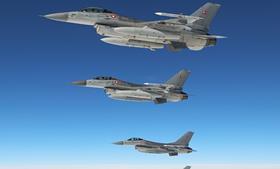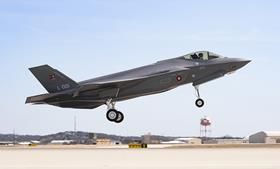In a major shake-up of the military balance in South America, Argentina has finalised a deal to purchase 24 used Lockheed Martin F-16 fighters from Denmark.
Argentine defence minister Luis Petri was in Denmark on 16 April to formalise the agreement with Copenhagen that will deliver Argentina’s first supersonic combat aircraft in over a decade.
“Today we are finalising the most important military aeronautical acquisition since 1983,” Petri said, referencing Argentina’s 1982 military defeat at the hands of the UK Royal Navy.
“With these new aircraft we are taking a transcendental step in our defence policy, recovering the supersonic capacity of our aviation and achieving the definitive entry of our air force to the technological challenges of the 21st Century,” Petri added, speaking from the Skrydstrup air base that houses the Royal Danish Air Force’s (RDAF’s) F-16 fighter wing.
Petri arrived at the meeting in the back seat of an RDAF F-16. Photos from the ceremony show the defence minister clad in an olive green flight suit, flanked by an F-16 sporting the blue-and-white roundel of the Argentine air force.
The defence ministry did not disclose the exact terms of the deal, including cost and delivery timeline.

However, Buenos Aires confirms it will receive both single-seat F-16A and two-seat F-16B models, which are used for advanced pilot training.
“The agreement includes the delivery of four flight simulators, eight engines and spare parts for the aircraft will be guaranteed for five years,” the ministry says. “In addition, the contract provides for the training of pilots and mechanics who will work on this weapon system.”
Denmark is in the process of upgrading its air force to the fifth-generation Lockheed F-35A, and decided to part ways with its older jets. Copenhagen plans to donate 19 of its ageing F-16s to Ukraine, while selling the remaining 24 to Argentina.

The first four Danish F-35s arrived at their home station in September 2023. Denmark expects to acquire 27 of the stealthy fighters in total.
The F-16 acquisition is a significant boost for Argentina, whose combat air power has consisted of 24 aged Douglas A-4 subsonic light-attack jets since the 2015 retirement of its last Dassault Mirage fighters.
The sorry state of Argentina’s air force stems from military action taken in the depths of the Cold War.
Argentina has been heavily restricted from acquiring advanced military technology since the country’s defeat in the 1982 Falklands War, in which Buenos Aires attempted to seize the South Atlantic islands by force from the UK, which exercises sovereignty over the territory.
In the aftermath of the war, London barred Argentina from accessing UK-made defence hardware, which included Martin-Baker ejection seats found in many fighters and BAE Systems avionics and aircraft.
Over the years, London also exerted diplomatic pressure on allies to block any deal involving American or European aircraft, including replacement Mirages, Swedish Saab Gripens, Israel Aircraft Industries Kfirs and Korea Aerospace Industries FA-50 light fighters.
However, the decades-long freeze appeared to be thawing in 2023, when the US Department of State indicated it would approve a third-party transfer of existing F-16s to Argentina from Denmark.

Since the F-16 is an American-made platform, US government approval is required for any overseas sales or the transfer of existing aircraft.
Last October, a US official speaking to FlightGlobal on the condition of anonymity said Washington strongly supported the deal between Denmark and Argentina, with the US government having been working for more than year to facilitate an agreement.
The move appears to be at least in part driven by Argentina’s consideration of a deal with the USA’s strategic competitor China. Buenos Aires is believed to have been entertaining an offer to purchase the JF-17 single-engined fighter – a joint production of Pakistan Aeronautical Complex and China’s Chengdu Aircraft Corporation.
Notably, the Chinese-soured JF-17 would have circumvented any export restrictions imposed by the UK.
The USA’s desire to counter geopolitical rivals, coupled with the availability of legacy American aircraft scheduled for retirement, gave the F-16 option an appeal it previously had not held.
The UK government in 2018 also slightly softened its stance on the sale of weapons to its former South Atlantic foe, potentially paving the way for its NATO allies to conduct the transaction.
“Our general position is that we will continue to refuse licences for export and trade of goods judged to enhance Argentine military capability,” the foreign office said at the time.
“However, where like-for-like equipment is no longer available, we may grant licences where we judge they are not detrimental to the UK’s defence and security interests,” it added.
The F-16 acquisition will be a move toward parity in South America, where Argentina’s regional neighbours far outclass its air combat capability.
Chile operates 35 F-16s, according to Cirium, while Brazil is in the process of fielding Saab’s latest Gripen E fighter – including examples produced under license in Brazil by Embraer – with plans for at least 36 aircraft.



















